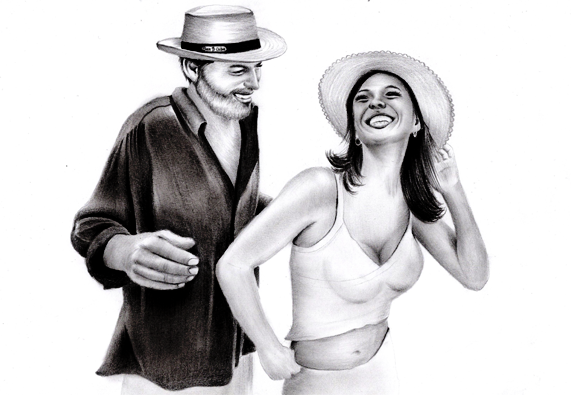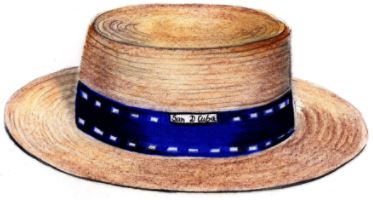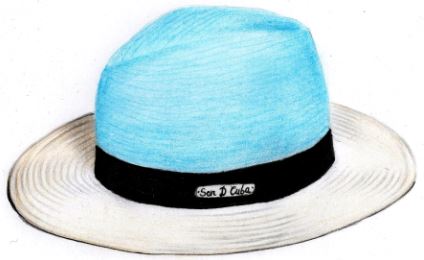
HISTORY OF THE CUBAN HAT
Since the invention of the hat, its evolution has been closely related to aspects such as social status and fashion, making the hat an accessory that provided style and reinforced the aesthetics of the wearer. The hats were even synonymous with some musical styles like the Cuban Son.
In the art of hat milling, there are many designs or types of hats that throughout history have been serving different roles and importance. Two of the most prominent and popular are perhaps the Canotier and Panama hats.
THE CUBAN CANOTIER HAT
Its manufacture follows the use of straw as the main fabric, forming its head with a flat cup and a straight shape to its wing. It is usually decorated with a blue or black band. In this definition, it is also known as: Canotier, Boater, Pork pie or Gondolero, being only differentiated among them by the most purists according to the type of straw and the braid of the same.
The Canotier Cuban Hat, Boater or Pork pie is a straw hat that supports both a formal and informal styles, adaptable to all kinds of situations. It is therefore considered among the best hats for its elegance, versatility and timelessness. In its origin, it was recognized as the hat of the people and was used by all social classes: actors, sportsmen, sailors and middle-class people in picnics, sporting events and weekend excursions as well as in more formal events. It also came to be considered, although used interchangeably by men and women, as an icon of the new woman thanks to its use by Coco Chanel in its visits to the hippodrome before the first world war.
In Cuba it was the typical image of the refined Cuban gentleman between the years 1914-1940, as a complement to the crude white suit ” dril cien ” so typical of the Caribbean island. Its use was generalized during the first decades of the twentieth century along with the Panama hat, of more flexible fiber, and the cloth Fedora hat. Although following the dress code established by England it could be used only in summer, the island’s climate made Cubans use it at any season of the year, just as it happened in other countries with warm climates.
Nowadays, it has recovered its importance being a basic in the closet of every man and woman who like to bring a distinctive and different touch to their daily look.
THE PANAMA HAT
With a design and features almost identical to the Fedora hat, its design features a wide brim with bent edges to create a depression at the top of the hat and a pinch in the front that gives forward shape. Its main difference from the Fedora is that it is made of straw. The classic color of the Panama hat is white with bands in different colors, but nowadays the designs are changing, offering a great variety of styles and colors. It originated in Ecuador, not Panama, and was popularized during the construction of the Panama Canal linking the Atlantic and Pacific at the beginning of the 20th century. Much of its fame also came due to the usual use given by Theodore Roosevelt, president of the United States at that time. Due to all of that it became the king of straw hats.
OTHER WELL-KNOWN HAT MODELS
There are other types of hats featured throughout history. The Fedora hat: originally a female-only hat and named after a late 19th-century French play in which a princess named Fedora appeared. Later it was popularized thanks to male actors like Humphrey Bogart who wore it in several films and turned it into one of the most popular hats for both men and women. The Bowler hat: Created in 1849 by the Bowler brothers in London, it was one of the most popular hats in America during the 19th century. The Stetson Hat: It is the quintessential cowboy hat, which was created by John B. Stetson in 1865. Finally, the Top Hat: created by John Hetherington in 1797, is considered as the first modern hat. Since its origin, it became a standard for formal and elegant dressing.
HISTORY OF THE CUBAN HAT

Since the invention of the hat, its evolution has been closely related to aspects such as social status and fashion, making the hat an accessory that provided style and reinforced the aesthetics of the wearer. The hats were even synonymous with some musical styles like the Cuban Son.
In the art of hat milling, there are many designs or types of hats that throughout history have been serving different roles and importance. Two of the most prominent and popular are perhaps the Canotier hat and Panama hat.
THE CUBAN CANOTIER HAT
Its manufacture follows the use of straw as the main fabric, forming its head with a flat cup and a straight shape to its wing. It is usually decorated with a blue or black band. In this definition, it is also known as: Canotier, Boater, Pork pie or Gondolero, being only differentiated among them by the most purists according to the type of straw and the braid of the same.
The Canotier Cuban Hat, Boater or Pork pie is a straw hat that supports both a formal and informal styles, adaptable to all kinds of situations. It is therefore considered among the best hats for its elegance, versatility and timelessness. In its origin, it was recognized as the hat of the people and was used by all social classes: actors, sportsmen, sailors and middle-class people in picnics, sporting events and weekend excursions as well as in more formal events. It also came to be considered, although used interchangeably by men and women, as an icon of the new woman thanks to its use by Coco Chanel in its visits to the hippodrome before the first world war.
In Cuba it was the typical image of the refined Cuban gentleman between the years 1914-1940, as a complement to the crude white suit ” dril cien ” so typical of the Caribbean island. Its use was generalized during the first decades of the twentieth century along with the Panama hat, of more flexible fiber, and the cloth Fedora hat. Although following the dress code established by England it could be used only in summer, the island’s climate made Cubans use it at any season of the year, just as it happened in other countries with warm climates.
Nowadays, it has recovered its importance being a basic in the closet of every man and woman who like to bring a distinctive and different touch to their daily look.
THE PANAMA HAT
With a design and features almost identical to the Fedora, its design features a wide brim with bent edges to create a depression at the top of the hat and a pinch in the front that gives forward shape. Its main difference from the Fedora is that it is made of straw. The classic color of the Panama hat is white with bands in different colors, but nowadays the designs are changing, offering a great variety of styles and colors. It originated in Ecuador, not Panama, and was popularized during the construction of the Panama Canal linking the Atlantic and Pacific at the beginning of the 20th century. Much of its fame also came due to the usual use given by Theodore Roosevelt, president of the United States at that time. Due to all of that it became the king of straw hats.
OTHER WELL-KNOWN HAT MODELS
There are other types of hats featured throughout history. The Fedora hat: originally a female-only hat and named after a late 19th-century French play in which a princess named Fedora appeared. Later it was popularized thanks to male actors like Humphrey Bogart who wore it in several films and turned it into one of the most popular hats for both men and women. The Bowler hat: Created in 1849 by the Bowler brothers in London, it was one of the most popular hats in America during the 19th century. The Stetson Hat: It is the quintessential cowboy hat, which was created by John B. Stetson in 1865. Finally, the Top Hat: created by John Hetherington in 1797, is considered as the first modern hat. Since its origin, it became a standard for formal and elegant dressing.




